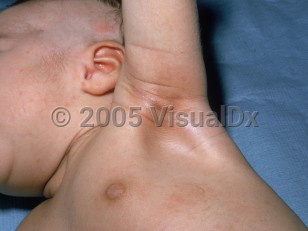Potentially life-threatening emergency
Congenital adrenal hyperplasia in Child
Alerts and Notices
Important News & Links
Synopsis

Congenital adrenal hyperplasia (CAH), also known as adrenogenital syndrome, is a group of genetic disorders caused by various defects in the genetic code for enzymes in the adrenal cortex, leading to varying degrees of enzyme activity and thus altered levels of adrenal cortical hormones, including mineralocorticoids (ie, aldosterone), glucocorticoids (ie, cortisol), and sex steroids (ie, testosterone and estrogen). The syndrome occurs when an enzyme deficiency leads to decreased adrenal synthesis of glucocorticoid, which impairs feedback inhibition on the pituitary gland. As a result, the pituitary gland secretes increased levels of adrenocorticotropic hormone (ACTH), which stimulates the adrenal glands to enlarge and produce more intermediate substrates. These intermediate substrates are shunted toward functioning arms of the hormone synthesis pathways, where increased levels of other hormones are produced (either mineralocorticoids or androgens, depending on the enzyme deficiency). Altered levels of mineralocorticoids and sex hormones lead to electrolyte abnormalities, problems with sexual differentiation, and other signs and symptoms, depending on the deficient enzyme and extent of the deficiency.
CAH can be classified into 2 main clinical presentations: classic salt-wasting and nonclassic. The clinical presentation of classic CAH is directly related to the amount of residual enzyme activity and can range from simple virilizing (previously called non-salt-wasting) to a life-threatening adrenal crisis.
There are multiple genetic enzyme defects that can lead to CAH. These include 21-hydroxylase deficiency, 11-beta-hydroxylase deficiency, 17-alpha-hydroxylase deficiency, 3-beta-hydroxysteroid dehydrogenase deficiency, P450 oxidoreductase deficiency, and congenital lipoid adrenal hyperplasia.
21-hydroxylase deficiency accounts for 95% of all cases of CAH and is inherited in an autosomal recessive pattern. It is due to a mutation of the CYP21 gene. Different genetic mutations result in varying degrees of enzyme activity, which correlate with the severity of clinical symptoms and presentation. CAH due to 21-hydroxylase deficiency can occur in a classic or nonclassic form. The incidence of the classic form is roughly 1:15 000, while that of the nonclassic form is approximately 1:100. Classic CAH due to 21-hydroxylase deficiency can be further divided into a salt-wasting form (75%) and a simple virilizing form (25%). 21-hydroxylase is necessary for the production of cortisol and aldosterone. Lack of this enzyme shunts intermediate steroid precursors toward androgen production. Symptoms are related to excess androgens and, in the salt-wasting form of classic CAH, decreased aldosterone. Aldosterone is necessary for normal sodium retention and potassium secretion by the kidney.
CAH can be classified into 2 main clinical presentations: classic salt-wasting and nonclassic. The clinical presentation of classic CAH is directly related to the amount of residual enzyme activity and can range from simple virilizing (previously called non-salt-wasting) to a life-threatening adrenal crisis.
There are multiple genetic enzyme defects that can lead to CAH. These include 21-hydroxylase deficiency, 11-beta-hydroxylase deficiency, 17-alpha-hydroxylase deficiency, 3-beta-hydroxysteroid dehydrogenase deficiency, P450 oxidoreductase deficiency, and congenital lipoid adrenal hyperplasia.
21-hydroxylase deficiency accounts for 95% of all cases of CAH and is inherited in an autosomal recessive pattern. It is due to a mutation of the CYP21 gene. Different genetic mutations result in varying degrees of enzyme activity, which correlate with the severity of clinical symptoms and presentation. CAH due to 21-hydroxylase deficiency can occur in a classic or nonclassic form. The incidence of the classic form is roughly 1:15 000, while that of the nonclassic form is approximately 1:100. Classic CAH due to 21-hydroxylase deficiency can be further divided into a salt-wasting form (75%) and a simple virilizing form (25%). 21-hydroxylase is necessary for the production of cortisol and aldosterone. Lack of this enzyme shunts intermediate steroid precursors toward androgen production. Symptoms are related to excess androgens and, in the salt-wasting form of classic CAH, decreased aldosterone. Aldosterone is necessary for normal sodium retention and potassium secretion by the kidney.
Codes
ICD10CM:
E25.0 – Congenital adrenogenital disorders associated with enzyme deficiency
SNOMEDCT:
237751000 – Congenital adrenal hyperplasia
E25.0 – Congenital adrenogenital disorders associated with enzyme deficiency
SNOMEDCT:
237751000 – Congenital adrenal hyperplasia
Look For
Subscription Required
Diagnostic Pearls
Subscription Required
Differential Diagnosis & Pitfalls

To perform a comparison, select diagnoses from the classic differential
Subscription Required
Best Tests
Subscription Required
Management Pearls
Subscription Required
Therapy
Subscription Required
References
Subscription Required
Last Reviewed:01/20/2021
Last Updated:01/12/2022
Last Updated:01/12/2022

